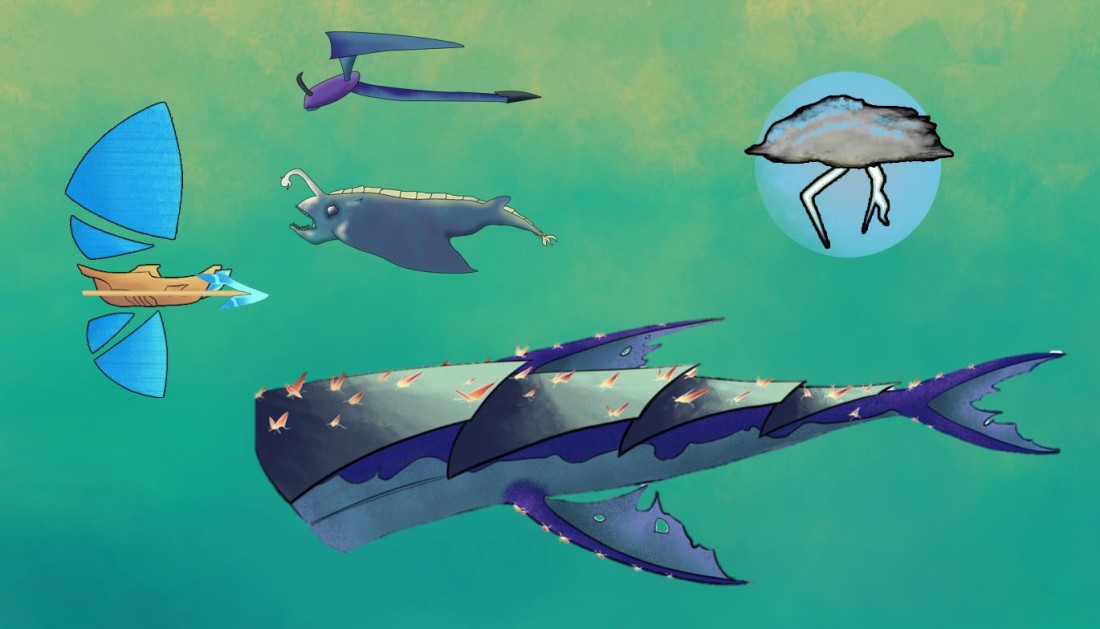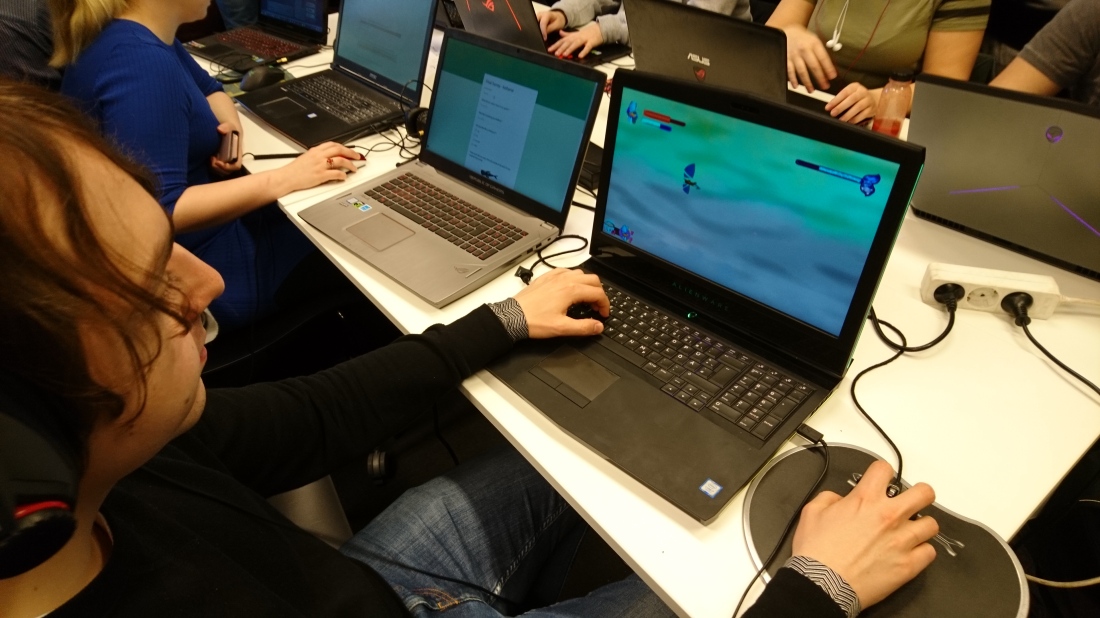All I needed was the last thing I wanted
To sit alone in a room and say it all out loud
During this Shoot ‘Em up project we, team Kraken, have accomplished a lot more than I had anticipated in the beginning. I had, for example, no idea how skilled the artists or the programmers were. In the end, I am happy that I ended up with the people I did. Even though our project has had its ups and downs. Especially after hearing how tough other teams had it with some of their own team members.
The game
The result of the project, our game, includes a player avatar with two different shooting mechanics, two enemies, a unique power up, whale boss appearances with some armor tearing off going on and the final boss fight (which is less polished than the other features).
I am very pleased and content with the game as a whole. The group has worked really hard throughout most of the project, and rarely complained about things, or stand-ups. Which is good! I as the manager didn’t have to twist my head around, figuring out how to make everyone’s wishes come true (since we were working in an agile way, every individual’s opinion matters).

What I have learned
This being the first project, and me being a manager for the first time, made me learn an abundance of new things. I feel like I gained experience points which will help me in the upcoming projects.
Few things I learned:
o More QA
I didn’t realize how important it is to assign a QA responsible person until it was few weeks left of the project. This goes especially for art assets. No QA resulted in disappointment in a few cases because there were things lacking in those assets and could’ve been avoided if another person would give feedback. (For example – this color doesn’t fit our background, it should be blue. Then the asset’s owner can change it quickly and the problem is solved)
o More Testing
Our game has a few difficult mechanics that are easy for us developers to understand, but not to the outsiders who play the game for the first time. This was especially apparent during the final playtesting session. It made me realize that we should have made more room for playtesting the game and let others playtest it to use the feedback and improve the gameplay. It was mostly the coders who did all the playtesting. Lesson learned.
During the last playtesting session, considering the feedback, it was visible what the majority of testers had issues with – the power up bugs and the final boss battle. For the final boss battle, you were supposed to shoot the harpoon at the whale’s mouth/tongue, which was not clear at all. We taught them in the beginning to tear armor plates off, and that is what they aimed for during the boss battle. This could’ve been avoided if we’d let someone from outside playtest the boss battle. Regarding the power up – when used during a checkpoint scene – it would bug the entire game – the background would be grey, the obstacles (islands) would be invisible and such things. In my opinion, we should not have aimed for this unique power up – which spawns a storm cloud and makes the enemies loose track of you. It is what it is.

o EXP gained in management and use of scrum/agile
With no previous experience or Minor lectures in Scrum, I tried my best to use this framework. It wasn’t too complicated to comprehend, especially incorporating the agile mindset by having the Agile manifesto in mind, at all times.
And like mentioned earlier, I was a manager for the first time, which in itself resulted in a lot of new knowledge about group dynamic, leadership etc.
o For next time – establish structure, rules (group contract, PID) in the beginning
I’ve already begun gathering information and lessons learned that I will use for the upcoming projects. A group contract and a PID (Project initiation document) will be the starting points. Since these documents are created by the whole team, the team members will have the power to decide and come up with rules that everyone will have to follow (more like a guideline than something set in stone – have to continue with agile mindset). I believe this will help with motivation and excitement to start working but will also serve us a helping hand in times of conflict.
Some positive things
The team itself is a positive thing. Most of the members took initiative and worked harder than necessary, which I am proud of, of course.
There were rarely any issues with code etc. to an extent that it had to be consulted with the teachers.
Meetings and stand-ups, I am especially happy about since all of the meetings had a positive effect on the group and the project and is something I will continue doing in the same pace. My team appreciated them a lot, and that I created weekly schedules that included time and place for: sprint reviews and plannings, daily stand-ups, a design meeting or two, in addition some other information related to game design course (like lectures, playtesting session…)
Some negative things
However, no team is perfect. I had issues with one team member in terms of communication throughout the whole project, which made the team irritated and confused. There were tasks done by Kim (pretend name) that were never discussed by the team and that weren’t supposed to be included in the game. The communication was biggest issue. I could rarely reach out to Kim, let alone get a response. In the end, it didn’t feel like Kim was fully a part of the team. I’m not saying that Kim was a total roadblock, Kim did do a lot of work and contributed to the team, nonetheless.
Another negative thing (related to communication once again), was that not everyone was active on our Slack channel. For most of the time it felt like a monolog, or dialog. This made me frustrated as a manager because I never knew who took part of the information posted there and who didn’t.
This was partially solved during a sprint retrospective which we started having after our scrum master, Raoul, introduced us to it. During the retrospective, the manager asks the team three questions: “What should we start doing?” “What should we stop doing?” and “What should we continue doing?”.
When the team was asked “What should we start doing”, a question regarding lack of activity on slack was raised. And a suggestion from the second-year scrum master came that we could incorporate a reaction system. As soon as you see a post, you react with an emote of your will.
This idea was awesome and helped tremendously. It didn’t feel like a monolog/dialog anymore.
Hey Juste, since I made the mistake of commenting on Elias’s blog last time, I’m commenting on yours this time. I found your post to be quite informative and easy to follow. The way you described your group dynamics was very open and honest (nice use of a fake name), but not in a way that you are bashing your problematic group member. It was nice to read after hearing about other people who are just going to write about how their team members were uncooperative.
I have taken a lot away from your post, it is clear that you learned a lot from this project and the fact that you took the feedback that you got into account and worked with it to improve your game was great. I also liked the fact that you included your scrum master and asked them for help when you had issues with your group, I wish that I had done that more often. I’m going to try and use the solutions that you and your scrum master came up with in regards to communication among the different team members.
Overall this is a great post, and I know that I give very unhelpful comments. I’m looking forward to seeing what you and your new team make in the next course!
M. Causey
LikeLiked by 1 person
Thank you for your feedback!! Your comment was definitely NOT unhelpful :D.
I’m glad you found it interesting and informative. 🙂
LikeLike
Very good post. The quick description you give of the game is clear but not excessively detailed, it helps the reader picture what the game looks like without disrupting the flow of the text. You also manage to clearly describe what you’ve learned and the circumstances regarding why said thing stood out to you (Such as Testing and QA). I personally really liked the way you listed posiitive and negative factors of the project and I feel like it definitely enhances the value of your post. Since every aspect you list from the project is something which can happen in all game development projects, I think the post can serve to give valuable insight for both aspiring project managers and experienced ones, assuming they have not yet encountered similar experiences. For example, I had similar experiences regarding playtesting in our project, and for that reason, that part of your post was not very significant to me. However I did not have any problems regarding communication over slack, and because of that, your post has made me aware of a possible way to deal with
LikeLiked by 1 person
Don’t know why my comment just posted itself? Anyway, I was just going to say that your post has made me aware of a wayu to deal with communication problems over Slack (The reaction system), and I will keep this in mind during future projects.
LikeLiked by 1 person